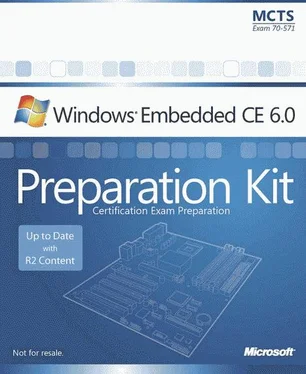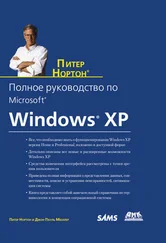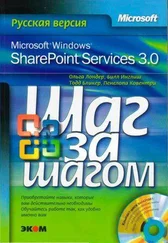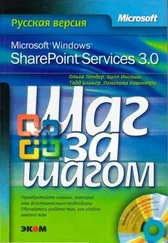Nicolas Besson - Microsoft Windows Embedded CE 6.0 Exam Preparation Kit
Здесь есть возможность читать онлайн «Nicolas Besson - Microsoft Windows Embedded CE 6.0 Exam Preparation Kit» весь текст электронной книги совершенно бесплатно (целиком полную версию без сокращений). В некоторых случаях можно слушать аудио, скачать через торрент в формате fb2 и присутствует краткое содержание. Город: Redmond, Год выпуска: 2008, Издательство: Microsoft, Жанр: Руководства, ОС и Сети, Программы, на английском языке. Описание произведения, (предисловие) а так же отзывы посетителей доступны на портале библиотеки ЛибКат.
- Название:Microsoft Windows Embedded CE 6.0 Exam Preparation Kit
- Автор:
- Издательство:Microsoft
- Жанр:
- Год:2008
- Город:Redmond
- ISBN:нет данных
- Рейтинг книги:5 / 5. Голосов: 1
-
Избранное:Добавить в избранное
- Отзывы:
-
Ваша оценка:
- 100
- 1
- 2
- 3
- 4
- 5
Microsoft Windows Embedded CE 6.0 Exam Preparation Kit: краткое содержание, описание и аннотация
Предлагаем к чтению аннотацию, описание, краткое содержание или предисловие (зависит от того, что написал сам автор книги «Microsoft Windows Embedded CE 6.0 Exam Preparation Kit»). Если вы не нашли необходимую информацию о книге — напишите в комментариях, мы постараемся отыскать её.
Microsoft Windows Embedded CE 6.0 Exam Preparation Kit — читать онлайн бесплатно полную книгу (весь текст) целиком
Ниже представлен текст книги, разбитый по страницам. Система сохранения места последней прочитанной страницы, позволяет с удобством читать онлайн бесплатно книгу «Microsoft Windows Embedded CE 6.0 Exam Preparation Kit», без необходимости каждый раз заново искать на чём Вы остановились. Поставьте закладку, и сможете в любой момент перейти на страницу, на которой закончили чтение.
Интервал:
Закладка:
Troubleshooting Build Issues
While analyzing build log files can give you great insight into the build process in general, it is most useful when troubleshooting build errors. If an error message is related to a source code file, you can jump to the relevant line of code by double- clicking the message entry in the Error List window. However, not all build errors are related to source code. Linker errors due to missing library references, sysgen errors due to missing component files, copy errors due to exhausted disk capacities, and make run-time image errors due to incorrect settings in run-time image configuration files can also cause a build process to fail.
Errors during the Sysgen Phase
Sysgen errors are generally the result of missing files. The Build.log file might provide detailed information about the reason. Components that you recently added to or removed from an OS design can cause this type of error if the required dependencies are unavailable. To diagnose a Sysgen error, it is a good idea to verify all changes related to catalog items and their dependencies. Also note that some components require you to perform a clean Sysgen build instead of a regular Sysgen cycle. Typically, you should not use the Clean Sysgen command because performing a clean Sysgen in Release or Debug build configuration requires you to perform a regular Sysgen in the other build configuration as well. However, when adding or removing catalog items and encountering Sysgen build errors afterward, during the next regular Sysgen, you might have to perform a clean Sysgen build to solve the issue.
Errors during the Build Phase
Build errors are typically caused by compiler errors or linker errors. Compiler errors are syntax errors, missing or illegal parameters in function calls, divisions by zero and similar issues that prevent the compiler from generating valid binary code. By double- clicking a compiler error, you can jump to the critical line of code. Keep in mind, however, that compiler errors can be the results of other compiler errors. For example, an incorrect variable declaration can cause numerous compiler errors if the variable is used in many places. It is generally a good idea to start at the top of the error list, fix the code, and recompile. Even small code changes can often eliminate a very large number of errors from the list.
Linker errors are harder to troubleshoot than compiler errors. They are typically the result of missing or incompatible libraries. Incorrectly implemented APIs can also result in linker errors if the linker cannot resolve external references to exported DLL functions. Another common cause has its root in incorrectly initialized environment variables. Build files, specifically the Sources file, use environment variables instead of hard-coded directory names to point to referenced libraries. If these environment variables are not set, the linker will not be able to locate the libraries. For example, %_WINCEROOT% must point to C:\Wince600 if you installed Windows Embedded CE in the default configuration and %_FLATRELEASEDIR% must point to the current release directory. To verify the values of environment variables, open the Build menu in Visual Studio and select Open Release Directory in Build Window, and then at the command prompt use the setcommand with or without an environment variable, such as set _winceroot. Running the setcommand without parameters displays all environment variables, but be aware that this list is long.
Errors during the Release Copy Phase
Buildrel errors encountered during the Release Copy phase are generally a sign of inadequate hard drive space. During the Release Copy phase, the build system copies files to the release directory. It might be necessary to free up hard drive space or place the OS design folder on a different drive. Make sure that the new path to the OS design folder contains no spaces because spaces in the path or in the OS design name cause errors during the build process.
Errors during the Make Run-Time Image Phase
Errors encountered during this final phase in the build process generally result from missing files. This can happen if a component failed to build in an earlier step, but the build process nevertheless continued to proceed to the Make Run-time Image phase. Syntax errors in .reg files or .bib files can lead to this situation when the build system is unable to create the Reginit.ini file or Ce.bib file. Makeimg.exe calls the FMerge tool (FMerge.exe) during the build process to create these files, and if this fails, such as due to incorrect conditional statements, you encounter a make-image error. Another possible error is Error: Image Exceeds ( X ), which means the image is larger than the maximum possible size specified in Config.bib.
Lesson Summary
Platform Builder for Windows Embedded CE 6.0 R2 integrates with the build-logging system of Visual Studio 2005 to provide you with convenient access to status information, warnings, and error messages generated during the build process and tracked in Build.log, Build.wrn, and Build.err files. Depending on how you start the build process in Visual Studio, these files reside either in the %_WINCEROOT% folder or in a subproject directory, yet the actual location of the files is not important because you can analyze the content from these files directly in the Output window and the Error List window in Visual Studio. It is not necessary to open these files in Notepad or another text editor.
By analyzing build log files, you can gain a better understanding of the build process in general and build issues in particular. Typical build issues you might encounter occasionally are compiler errors, linker errors, Sysgen errors, build errors, and other errors generated during the Release Copy and Make Run-time Image phases. If a build error is related directly to a line in a source code file, you can double-click the message entry in the Error List window, and Visual Studio automatically opens the source-code file and jumps to the critical line. Other issues, such as buildrel errors due to inadequate hard drive space, require you to perform troubleshooting steps outside of the Visual Studio IDE.
Lesson 4: Deploying a Run-Time Image on a Target Platform
Having solved all build issues and successfully generated a run-time image, you are ready to deploy Windows Embedded CE on the target device. There are several ways to accomplish this task. The method you choose depends on the startup process you use to load Windows Embedded CE on the target device. There are several ways you can start a Windows Embedded CE 6.0 run-time image. You can start an image directly from ROM, in which case you must deploy the run-time image on the target device by using a ROM tool. You can also use a boot loader, and then either download the run-time image every time the device starts or store the image in persistent memory for reuse. Windows Embedded CE 6.0 R2 comes with generic boot-loader code that you can customize according to your specific needs. It is also straightforward to implement a third-party boot loader. Essentially, Windows Embedded CE can accommodate almost any start environment, and makes it easy to download new run-time images quickly and conveniently during the development cycle and for release to the end user.
After this lesson, you will be able to:
■ Decide how to deploy a run-time image on a target device.
■ Configure Platform Builder to select the correct deployment layer.
Estimated lesson time: 15 minutes.
Choosing a Deployment Method
In order to deploy a run-time image, you must establish a connection to the target device. This requires you to configure several communication parameters that determine how Platform Builder communicates with the device.
Читать дальшеИнтервал:
Закладка:
Похожие книги на «Microsoft Windows Embedded CE 6.0 Exam Preparation Kit»
Представляем Вашему вниманию похожие книги на «Microsoft Windows Embedded CE 6.0 Exam Preparation Kit» списком для выбора. Мы отобрали схожую по названию и смыслу литературу в надежде предоставить читателям больше вариантов отыскать новые, интересные, ещё непрочитанные произведения.
Обсуждение, отзывы о книге «Microsoft Windows Embedded CE 6.0 Exam Preparation Kit» и просто собственные мнения читателей. Оставьте ваши комментарии, напишите, что Вы думаете о произведении, его смысле или главных героях. Укажите что конкретно понравилось, а что нет, и почему Вы так считаете.








